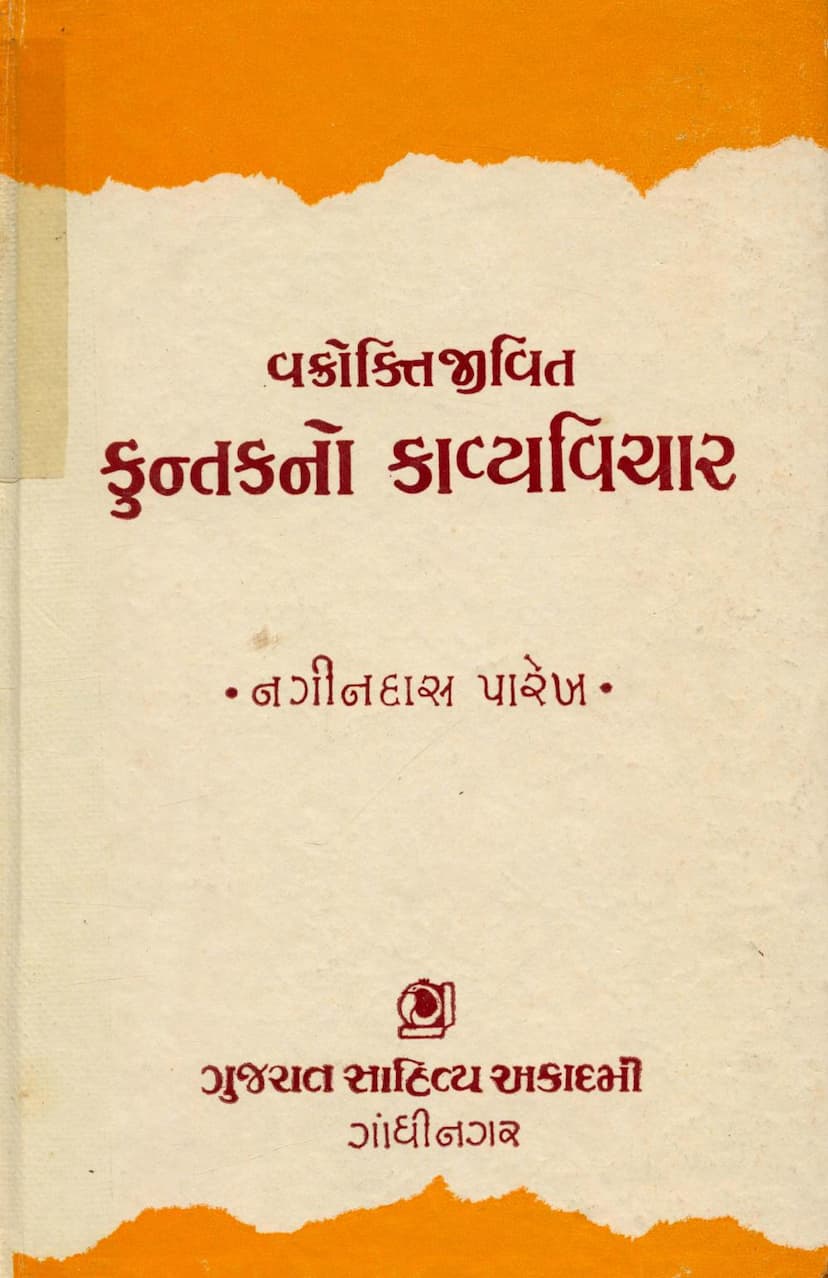Vakrokti Jivit Kuntakno Kavya Vichar
Added to library: September 2, 2025

Summary
Here is a comprehensive summary of the Jain text "Vakrokti Jivita Kuntakno Kavya Vichar" by Nagindas Parekh, based on the provided pages and catalog link:
Book Title: Vakrokti Jivita Kuntakno Kavya Vichar (वक्रोक्तिजीवित कुन्तकनो काव्यविचार) Author: Nagindas Parekh (नगीनदास पारेख) Publisher: Gujarat Sahitya Academy (गुजरात साहित्य अकादमी) Publication Date: September 1988 (First Edition)
Overall Subject: The book delves into the poetic philosophy and theory of the renowned Sanskrit literary critic Kuntaka, particularly his central concept of "Vakrokti" (indirect speech or figurative language) as presented in his seminal work, "Vakrokti Jivita." Nagindas Parekh's contribution lies in editing and translating Kuntaka's profound ideas into Gujarati, making them accessible to Gujarati readers and scholars.
Key Aspects and Themes:
-
Introduction to Kuntaka and Vakrokti:
- Kuntaka is highlighted as a prominent figure in Indian poetics, offering a unique perspective on the nature, impact, and creation of poetry.
- His work, "Vakrokti Jivita," emerged during a period when Sanskrit literary criticism had reached a high level, yet Kuntaka managed to introduce original theoretical concepts.
- The core of Kuntaka's thought is "Vakrokti" (वक्रोक्ति), which he defines as the essential characteristic of poetry. It signifies a deviation from the straightforward, common, or conventionally accepted mode of expression. Poetry's utterance is vakra (crooked or figurative), whereas ordinary language is vayas (straight or literal).
- Vakrokti is described as extraordinary, peculiar, beautiful, skillful, and a result of the insightful poet's activity. It's about expressing the intended meaning in a unique and impactful way that resonates with the sensitive audience.
-
Kuntaka's Definition of Poetry:
- Kuntaka defines poetry as the union of shabda (word) and artha (meaning), but not just any word and meaning. They must be intertwined and presented in a specific bandha (structure or composition) that is the result of the creator's unique chhatayukt srujanvyapar (creative process characterized by flair or skill) and pleasing to the sensitive recipient (sahru daya).
- This definition is praised for encompassing the author, the reader, the work itself, and its various aspects like meaning, style, and structure, thus avoiding the pitfalls of excessive focus on any single element (e.g., author-centric, work-centric, or reader-centric).
-
The Nature of Vakrokti:
- Vakrokti is presented as the "lifeblood" (jivita) of poetry, responsible for the lokottar-chamata (supernatural wonder) experienced by the audience.
- It goes beyond the common usage of language, transcending the ordinary conventions of expression. Kuntaka argues that poets must depart from the usual path to convey their intended meaning effectively and poetically.
- The book elaborates on various types and manifestations of Vakrokti at different levels of poetic composition, from words to entire narratives.
-
Kuntaka's Unique Approach:
- Kuntaka's analysis of poetic elements is noted for its independence and logical strength.
- He acknowledges concepts like marga (path/style) and guna (quality) from the Riti school of criticism but redefines and reorganizes them according to his own framework.
- He proposes three main margas: sukumar (delicate/graceful), vichitra (diverse/extraordinary), and madhyam (middle/balanced).
- His classification of qualities (madhurya, prasada, lavanya, abhijatya, auchitya, saubhagya) within these paths is considered robust and avoids scholastic rigidity, leaving room for the reader's aesthetic experience.
- Kuntaka's view that margas are not tied to geographical determinisms but rather to the poet's innate nature (svabhava), power (shakti), learning (vyutpatti), and practice (abhyasa) is considered strikingly modern.
-
Treatment of Alamkaras (Figures of Speech):
- Kuntaka presents a critical analysis of Alamkaras, particularly arthalankaras (figures of speech related to meaning).
- He questions the proliferation of Alamkaras by earlier theorists, exercising a discerning eye.
- He outright rejects certain figures like svabhavokti, preyas, ujjvasvi, udar, ashish, samahita, visheshokti, yathasamkhya, hetu, sukshma, and lesha as independent alamkaras.
- Instead, he integrates many concepts, such as upama, tulyaogita, anvay, parivrutti, nidharshana, and padarthopama, as subordinate forms or aspects of Upama (simile).
-
Analysis of the Work:
- The book is structured systematically, with Kuntaka's "Vakrokti Jivita" being the primary text.
- The first Unmesh (Chapter/Section) discusses the definition and purpose of poetry.
- Subsequent Unmeshas analyze various elements like varna (letters), pada (words), vakya (sentences), prakarana (chapters), and prabandha (entire works), detailing the application of vakrata at each level.
- Kuntaka's interpretations and analyses of specific literary works are highly regarded for their insight and relevance even today.
-
The Translator's Contribution (Nagindas Parekh):
- The preface and acknowledgments highlight the arduous task of translating and editing such a complex Sanskrit text into Gujarati.
- Parekh's deep knowledge of Sanskrit and Indian poetics is evident.
- The Gujarat Sahitya Akademi is acknowledged for its support, and gratitude is expressed to Karnatak University for permission to use Dr. K. Krishnamurthy's Sanskrit text.
- The publication aims to make Kuntaka's valuable contributions accessible to the Gujarati literary community.
Jain Context: While the book itself is a work of literary criticism and poetics, the catalog link points to the Jain Vidya section of the Jain QQ website. This suggests that the text might be preserved or cataloged within Jain libraries or educational institutions, perhaps due to Parekh's own scholarly interests or because Jain traditions value philosophical and aesthetic discourse that can complement their own intellectual heritage. However, the content summary directly from the provided text focuses solely on Kuntaka's poetics and does not reveal any explicit Jain doctrines or interpretations within Kuntaka's theory itself. The Jain connection is primarily one of preservation and accessibility through the Jain Education International platform.
In essence, "Vakrokti Jivita Kuntakno Kavyavichar" is a scholarly translation and commentary on Kuntaka's influential theory of "Vakrokti," emphasizing the unique and figurative use of language as the core of poetic beauty and expression.